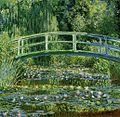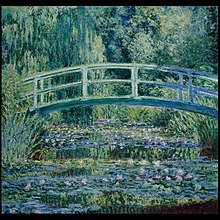Soubor:Water-Lilies-and-Japanese-Bridge-(1897-1899)-Monet.jpg

Velikost tohoto náhledu: 617 × 599 pixelů. Jiná rozlišení: 247 × 240 pixelů | 494 × 480 pixelů | 791 × 768 pixelů | 1 031 × 1 001 pixelů.
Původní soubor (1 031 × 1 001 pixelů, velikost souboru: 381 KB, MIME typ: image/jpeg)
Historie souboru
Kliknutím na datum a čas se zobrazí tehdejší verze souboru.
| Datum a čas | Náhled | Rozměry | Uživatel | Komentář | |
|---|---|---|---|---|---|
| současná | 19. 1. 2009, 22:57 |  | 1 031 × 1 001 (381 KB) | Krscal | {{Information |Description={{en|1=Water Lilies and Japanese Bridge (1897-1899) by Claude Monet Princeton University Art Museum}} |Source=the-athenaeum.org http://www.the-athenaeum.org/art/full.php?ID=3788 |Author=Claude Monet |Date=1897-1899 |Permission= |
Využití souboru
Tento soubor používá následující stránka:
Globální využití souboru
Tento soubor využívají následující wiki:
- Využití na ceb.wikipedia.org
- Využití na cy.wikipedia.org
- Využití na en.wikipedia.org
- Využití na en.wikivoyage.org
- Využití na et.wikipedia.org
- Využití na fr.wikivoyage.org
- Využití na ja.wikipedia.org
- Využití na kbp.wikipedia.org
- Využití na lv.wikipedia.org
- Využití na pl.wikipedia.org
- Využití na pt.wikipedia.org
- Využití na ro.wikipedia.org
- Využití na sl.wikipedia.org
- Využití na sq.wikipedia.org
- Využití na sv.wikipedia.org
- Využití na ta.wikipedia.org
- Využití na vi.wikipedia.org



